Nonprofit organizations play a crucial role in society, and having a strong online presence is essential for increasing visibility, reaching more people, and attracting support. Search Engine Optimization (SEO) for nonprofits is a powerful tool to achieve these goals. By understanding and implementing SEO best practices, nonprofits can improve their website’s ranking factor SEO performance, rank higher on search engine result pages, and drive more organic traffic to their platforms.
What Is SEO for Nonprofits?

SEO is the process of researching relevant keywords related to the organization’s mission and using them strategically throughout the website’s content. This process of optimizing for keywords helps search engines understand the purpose of the website and rank it higher for relevant searches. Additionally, nonprofit SEO involves optimizing website technical elements such as meta tags, image alt tags, and heading tags to ensure that search engines can easily crawl and index the site. Furthermore, creating high-quality and relevant content that resonates with the target audience is crucial for nonprofit SEO. This could include blog posts, case studies, success stories, and other forms of content that engage and educate visitors.
Nonprofit SEO also involves building high-quality backlinks from reputable websites to improve the site’s authority and credibility in the eyes of search engines. Moreover, optimizing the website for mobile devices is essential, as more and more people access the internet through smartphones and tablets. Measuring and analyzing the performance of nonprofit SEO efforts is crucial for ongoing improvement. Tools like Google Analytics can help nonprofits track organic traffic, user behavior, and other key metrics to understand what’s working and what needs improvement.
Overall, nonprofit SEO is a valuable strategy for organizations looking to increase their online presence and achieve their mission-driven goals. By implementing effective SEO strategies, nonprofits can reach a larger audience, raise more funds, and make a greater impact in their communities.
Nonprofit SEO Basics for Better Search Engine Ranking
For nonprofit organizations, understanding the basics of SEO is crucial for increasing their online visibility and attracting potential donors, volunteers, and supporters. SEO, or search engine optimization, involves optimizing your website and online content to rank higher on search engine results pages. By incorporating relevant keywords, creating quality content, and improving website performance, nonprofits can reach a wider audience and ultimately fulfill their mission more effectively. Nonprofits can also benefit from local SEO strategies to target specific geographic areas and connect with local communities. Additionally, understanding the importance of backlinks, user experience, and mobile optimization can further enhance a nonprofit’s online presence. By investing time and resources into learning and implementing SEO best practices, nonprofits can improve their digital marketing efforts, increase their impact, and ultimately make a difference in the causes they support.
When implementing SEO for nonprofits, keyword research is crucial. This process involves identifying relevant keywords and phrases that people search for on search engines. By understanding the target keywords, nonprofits can create content that aligns with search intent, ultimately improving their website’s ranking on search engine result pages. Additionally, nonprofits should focus on creating high-quality, valuable content that is relevant to their audience and incorporates these keywords naturally. This can include blog posts, articles, case studies, and other resources that provide useful information and demonstrate the nonprofit’s expertise in their field.
Nonprofits should also optimize their website for technical SEO, including improving site speed, mobile-friendliness, and ensuring proper site structure and navigation. This can help search engines crawl and index the site more effectively, leading to better search visibility.
Another important aspect of good SEO for nonprofits is building quality backlinks from reputable websites. This can be achieved through outreach, partnerships, and creating shareable content that other websites will want to link to.
Finally, nonprofits should regularly monitor and analyze their SEO efforts using tools like Google Analytics and Google Search Console. This can provide valuable insights into website performance, keyword rankings, and user behavior, allowing nonprofits to make data-driven decisions to continually improve their SEO strategy. Overall, implementing SEO for nonprofits requires a strategic approach, ongoing effort, and a focus on providing value to their audience.
Optimize for Effective SEO Best Practices for Nonprofits
Keyword Research Best Practice
Nonprofits often rely on fundraising, and effective keyword research can help them target keywords related to their cause, increasing their visibility for relevant searches. By conducting thorough keyword research, nonprofits can identify the terms and phrases that their target audience is using to search for information related to their cause. This allows them to incorporate these SEO keywords into their website content, blog posts, and social media campaigns, making it easier for potential supporters to find their organization.
Additionally, keyword research can help nonprofits identify trending topics and issues within their cause area, allowing them to tailor their fundraising efforts to align with current interests and concerns. This can help them create more compelling and relevant messaging that resonates with their audience and encourages them to support the organization financially.
In essence, effective keyword research can help nonprofits improve their online visibility, attract more supporters, and ultimately increase their fundraising success. It’s an essential tool for organizations looking to make a tangible impact in the digital landscape and effectively reach potential donors and advocates.
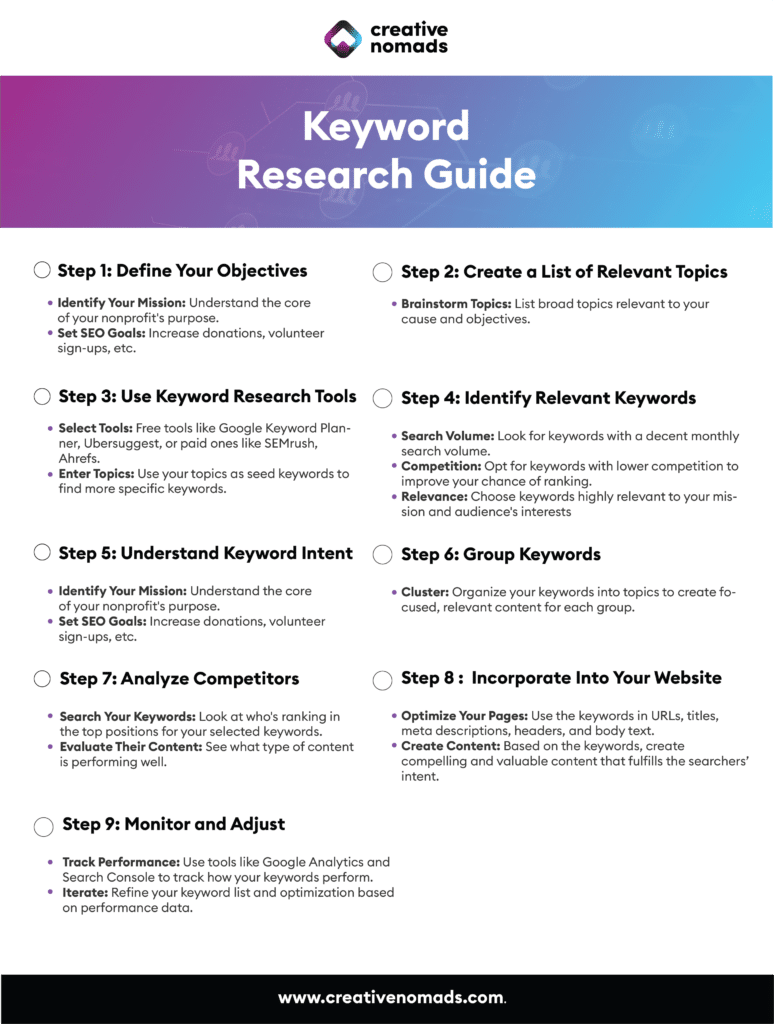
On-Page SEO Strategies
Optimizing the website’s meta descriptions, titles, and content to include relevant keywords can improve its search engine ranking. Meta descriptions and titles are key components of a website’s search engine optimization (SEO) strategy. By including relevant keywords in these areas, you can improve the site’s visibility in search engine results pages.
When optimizing meta descriptions, it’s important to use compelling language that entices users to click through to the website. Including relevant keywords in the meta description can help signal to search engines what the page is about, improving its chances of ranking for those keywords.
Similarly, optimizing page titles with relevant keywords can help improve search engine rankings. Page titles are often the first thing users see in search results, so including keywords that accurately reflect the page’s content can help attract clicks and improve visibility.
In addition to meta descriptions and page titles, it’s also important to include relevant keywords throughout the website’s content. This helps search engines understand what the website is about and can improve its chances of ranking for relevant search queries.
Overall, optimizing meta descriptions, titles, and content with relevant keywords is a key aspect of SEO that can help improve a website’s search engine ranking and visibility.
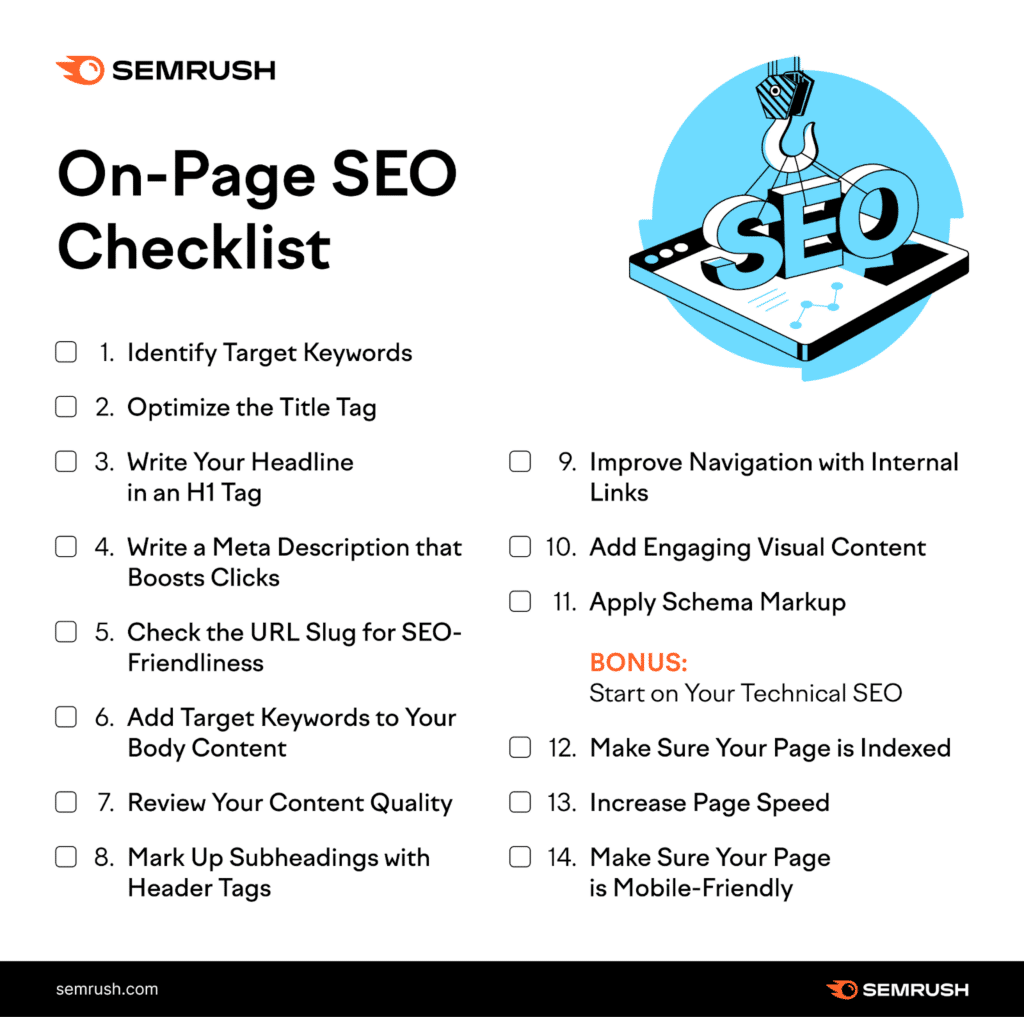
Off-Page SEO Tips
Beyond the content on your website, off-page SEO focuses on building your domain authority and online reputation. This section details two key strategies:
- Backlink Building: Earning backlinks (links from other websites to your website) is crucial. When reputable, high-authority websites link to your content, it signals to search engines that your website is trustworthy and valuable. Focus on acquiring backlinks from websites relevant to your cause, such as industry publications, news outlets, or partner organization websites. Here are ways to build backlinks:
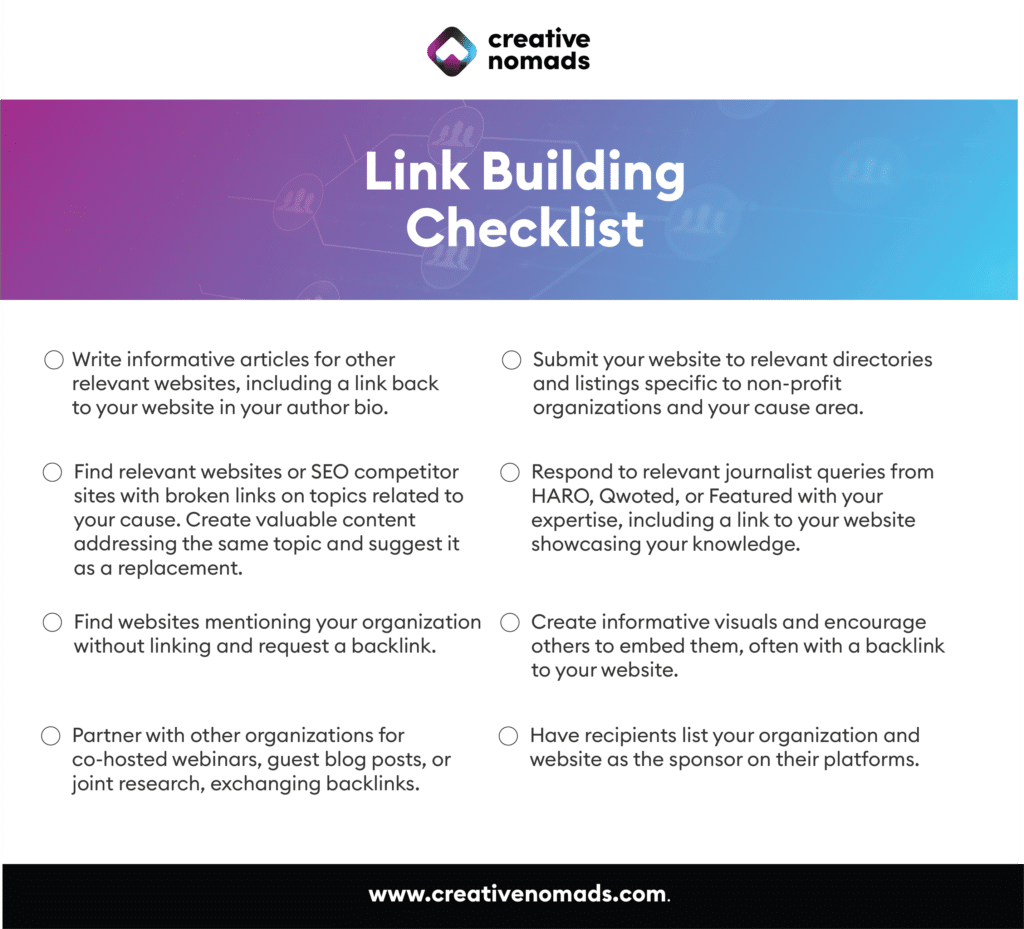
- Online Presence & Brand Mentions: Increase your online visibility by actively engaging with your community and building your brand reputation online. Here are some tactics:
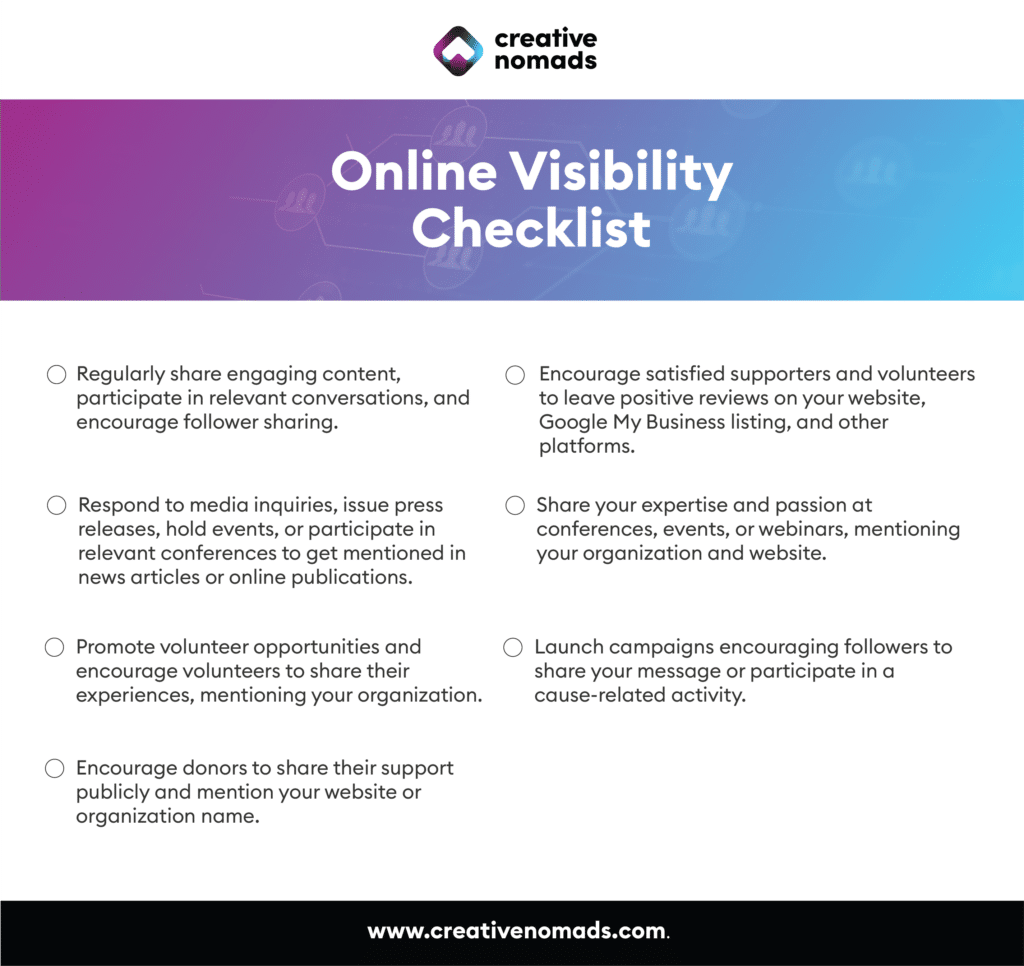
- Local community engagement: Get involved in local events, volunteer, or sponsor initiatives to foster positive connections and potentially gain local news coverage and online mentions.
Building backlinks and online presence takes time and effort. Focus on creating high-quality content, building genuine relationships with other organizations, and providing value to your target audience. Consistently implementing these off-page SEO strategies can increase your website’s authority and visibility, attracting more organic traffic and ultimately making a bigger impact online.
Technical SEO Best Practices
Ensuring the website is technically optimized for search engines can improve its performance and search engine rankings. Technical optimization for search engines involves several key elements:
1. Website speed: A fast-loading website is essential for both user experience and search engine rankings. Ensuring that your website is optimized for speed can improve its performance in search results. Use PageSpeed Insights or GTMetrix to figure out areas you can improve.

2. Mobile-friendliness: With the majority of internet users accessing websites on mobile devices, it is crucial that your website is optimized for mobile. This includes responsive design, which ensures that the website layout adjusts to different screen sizes, and mobile-friendly features such as easy navigation and quick loading times.

3. Crawlability and indexing: Search engines use bots to crawl and index websites, so it’s important to ensure that your website’s structure and content are easy for search engine bots to access and understand. This involves using clear and descriptive HTML tags, creating a sitemap, and avoiding technical issues that could block search engine bots from accessing your site by checking your robots.txt. To check, just enter your website and add sitemap.xml and robots.txt


4. URL structure: Using clear, descriptive URLs that include relevant keywords can help search engines understand the content of your website and improve its rankings for those keywords. Don’t use spaces as they result to random characters in your URL. Say for example, this blog post has a URL of: https://creativenomads.com/blog/seo-for-nonprofits

5. Schema markup: Implementing schema markup on your website can help search engines understand the specific types of content on your site, such as articles, events, products, and more. This can lead to rich snippets in search results, which can improve click-through rates.
6. Canonicalization: Using canonical tags can help prevent duplicate content issues, which can negatively impact search engine rankings. A canonical URL is the version of a webpage chosen by search engines like Google as the main version when there are duplicates. This selected URL is prioritized to avoid showing repetitive content that does not provide unique value in search results.
Canonical URL: https://example.com/blog/
Alternate URL: https://example.com/blog/?page=1
In this example, Google will likely choose the canonical URL for indexing and ranking. The canonical page is also called the “principal,” “primary,” or “representative” version. In other cases, you use canonical tags for:
- American English and British English versions of the same page
- Parameterized URLs (e.g., listings pages with filters or sorting options applied)
Why avoid duplicate content?
Because it can cause keyword cannibalization. This occurs when multiple pages on a site compete for the same rankings. And harm each other’s rankings in the process.
Overall, ensuring technical optimization for search engines involves multiple elements that work together to improve a website’s performance and search engine rankings. By addressing these technical aspects, website owners can create a strong foundation for their SEO efforts.
2024 SEO Approach: Top Factors That Influence SEO & Tips to Rank Higher
Search engine rankings can be influenced by various factors, including the website’s technical setup, content quality, relevance, and backlink profile. Understanding these factors is crucial for nonprofits looking to improve their SEO performance.
One important ranking factor in search engine rankings is the technical setup of the website. This includes factors such as page load speed, mobile-friendliness, secure HTTPS connection, and proper HTML markup. Nonprofits need to ensure that their website is technically optimized for search engines to crawl and index the content effectively.
Content quality is another critical factor that affects search engine rankings. Nonprofits should focus on creating high-quality, original, and relevant content that provides value to their target audience. This includes using relevant keywords, providing useful information, and keeping the content up to date.
Relevance is also essential for search engine rankings. Nonprofits need to ensure that their website is relevant to the searches their target audience is making. This involves using the right keywords, creating content that addresses the needs and interests of their audience, and ensuring that the website’s structure and navigation are user-friendly.
Additionally, the backlink profile of a website can significantly impact its search engine rankings. Nonprofits should aim to earn high-quality backlinks from reputable and relevant websites. This can be achieved through content partnerships, guest blogging, and creating shareable content that other websites may link to.
Overall, improving search engine rankings for nonprofits requires a strategic approach that considers technical setup, content quality, relevance, and backlink profile. By understanding and optimizing these factors, nonprofits can use SEO to increase their visibility and reach a broader audience through organic search.
21 SEO Tips and Tricks for Your Nonprofit Organization
1. Conduct Comprehensive Keyword Research: The first step in a successful SEO strategy is to understand what your target audience is searching for. This involves using tools like Google Keyword Planner or SEMrush. With these tools, nonprofits can discover keywords related to their mission, services, and location.
Focus on finding terms with high search volumes but low competition, as these are opportunities to attract more traffic with less competitive content.
For example, a nonprofit focused on environmental conservation might use these tools to find words and phrases like “local recycling programs” or “how to save endangered species.” Regularly updating your keyword list is crucial as trends and search patterns change over time. You can find more keywords by searching on a keyword research tool your main keywords and then filtering the results by difficulty (we suggest going for keywords with 49 or less keyword difficulty), search volume (the higher the better), and intent (go for informational intent keywords for blogs) which we will discuss more about below.
2. Align Content with Search Intent: Understanding why users search for specific terms is key to creating effective content. This means developing material that addresses users’ queries, whether they’re seeking information (informational intent), trying to find a specific website (navigational intent), or looking to perform an action like donating (transactional intent).
For instance, if someone searches for “how to volunteer for animal shelters,” they are likely looking for actionable information. Creating content that directly answers these queries not only satisfies user needs but also improves your website’s performance in search engine rankings.
3. Optimize Website for User Experience: A website that is easy to navigate and accessible to all users, including those with disabilities, is more likely to retain visitors and rank higher in search engines. This means regularly updating the design and content to keep it engaging and fresh.
For example, ensuring that your website has text-to-speech capabilities or is easily navigable for someone using a screen reader can significantly enhance user experience. Tools like WAVE (Web Accessibility Evaluation Tool) can help identify accessibility issues on your website.
4. Enhance Page Loading Speed: Page loading speed is a crucial factor in both user experience and search engine rankings. Nonprofits should use tools like Google PageSpeed Insights to identify and fix issues slowing down their website. A faster loading website reduces bounce rates as visitors are more likely to stay on the site. For example, compressing images and minimizing JavaScript can significantly improve loading times. We used GTMetrix below to check what can be improved on a website.
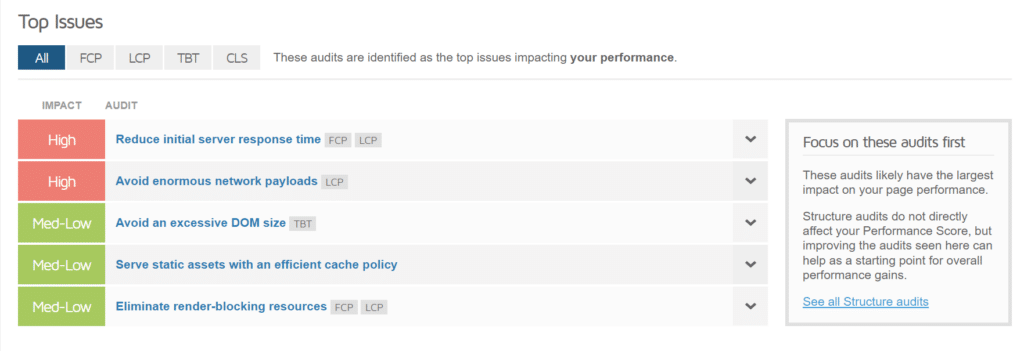
5. Focus on Overall Page Experience: Beyond speed, ensuring your nonprofit website is secure (using HTTPS), mobile-friendly, and free of intrusive pop-ups is essential for a positive user experience. These elements are crucial for retaining visitors and improving rankings. For instance, a mobile-responsive website ensures that users accessing your site from smartphones have an optimal viewing experience. Ensure that buttons and links are large enough for tapping on screen is also really important.
6. Implement Local SEO Practices: For nonprofits serving specific geographic areas, local SEO is vital. This includes creating a Google Business Profile listing, using local keywords in your content, and obtaining local backlinks. For example, a nonprofit operating in Seattle could optimize for terms like “Seattle food banks” or “homeless shelters in Seattle.” This local focus helps attract supporters and volunteers in the relevant area.
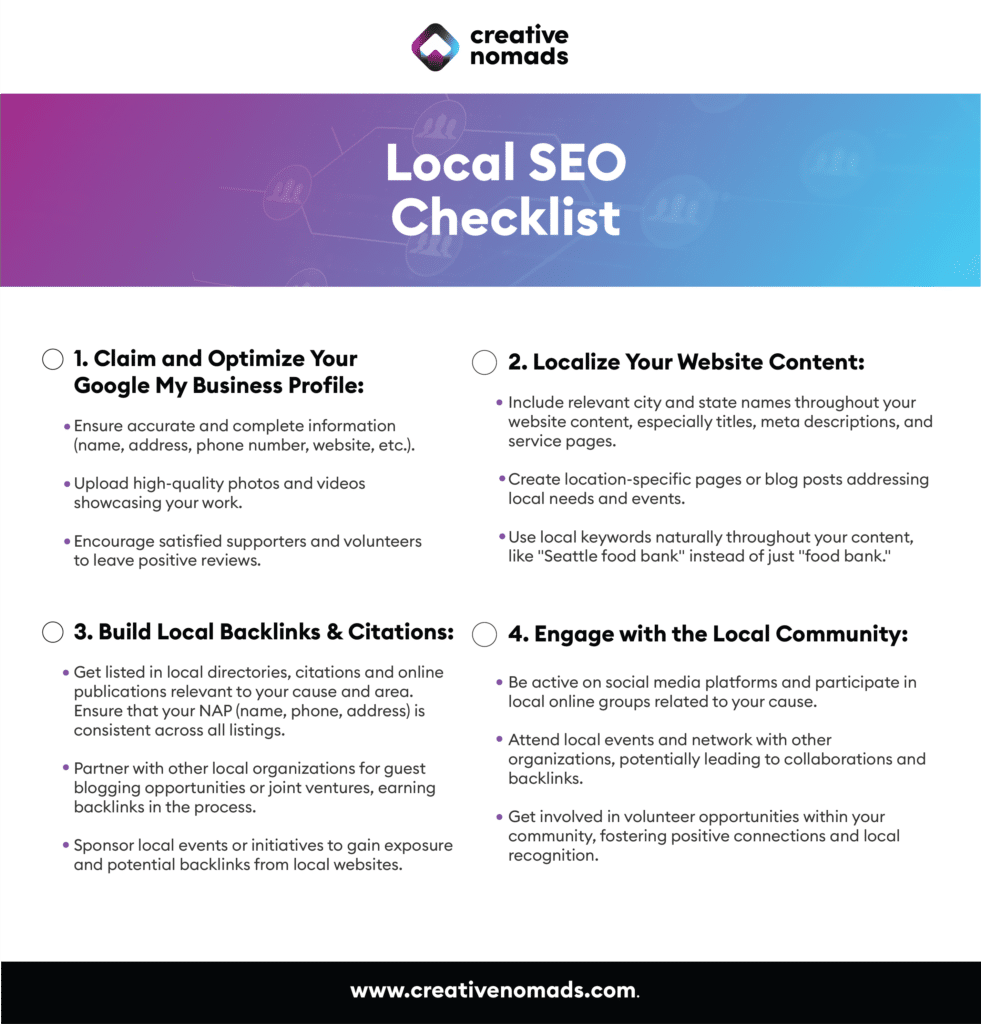
7. Encourage and Manage Online Reviews: Positive reviews from beneficiaries, volunteers, and donors can greatly enhance a nonprofit’s credibility and search rankings. Actively seek reviews and engage with them by responding. For instance, encourage volunteers to leave reviews on your Google Business Profile or other well-known directories for nonprofits and respond to these reviews to show engagement.

8. Implement Multilingual SEO for Wider Reach: If your audience is global, offering content in multiple languages can significantly broaden your reach. Using hreflang tags helps in targeting different languages and regions, ensuring that users see content in their preferred language. Accurate translations and cultural appropriateness are essential.
For example, a nonprofit with a global presence might offer content in English, Spanish, and French to cater to a broader audience.
9. Publish Expert, Trustworthy Content (E-E-A-T): High-quality content that demonstrates your nonprofit’s expertise and authority can significantly boost your SEO. This could include detailed blog posts, whitepapers, or research studies on topics relevant to your cause.
For example, publishing a well-researched whitepaper on the impacts of climate change can establish your nonprofit as a knowledgeable and reliable source in the environmental sector.
Aside from publishing it on your own website, you can also publish it on:
- Industry Publications: Submit your white papers to trade magazines or journals to reach a broader industry audience and bolster your expertise.
- Online Directories: Use platforms like SlideShare, Scribd or Academia.edu to publish and distribute your white papers to a larger audience.
- LinkedIn: Share your white paper on LinkedIn to engage with professionals in your industry.
- Research Databases: For original research, consider submitting your white paper to databases like SSRN or ResearchGate to extend its reach to researchers and academics.
10. Utilize Topic Clusters for Better Structure: Organizing your website’s content into topic clusters can improve its structure, making it easier for search engines to understand and rank your content. For instance, a nonprofit focusing on mental health could have a cluster around “mental health resources,” with interlinked articles on different aspects like therapy, support groups, and self-care tips.
11. Invite Industry Experts to Contribute: Featuring guest posts from respected figures in your field can enhance your website’s credibility and attract a broader audience. This also adds variety to your content. For example, inviting a well-known environmental activist to write a blog post on your site about conservation strategies can lend significant credibility and draw attention. You can do this by creating a Write for Us page and posting about it on social media. You can also request insights from industry experts via Featured by creating a publisher account.
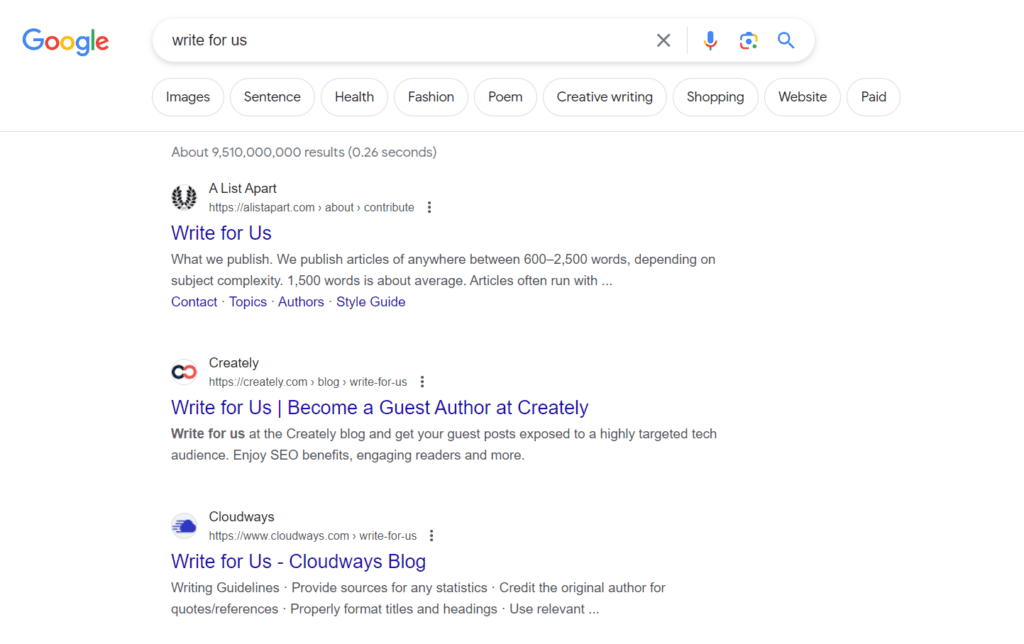
12. Target Educational Keywords: Focusing on content that educates about your cause can attract visitors seeking information. Your nonprofit blog might include ‘how-to’ guides, FAQs, or informational articles. For example, an animal welfare nonprofit might create content around “how to care for rescue pets” or “steps to adopt a pet.”
13. Provide and Regularly Update Statistical Data: Offering current statistics related to your cause and regularly updating this data makes your content relevant and trustworthy. For instance, one of our client, Samaritan Aviation, has made their impact on medical emergencies in Papua New Guinea publicly known.

14. Effectively Interlink Your Content: Internal linking between related content on your website improves user navigation and search engine indexing. For example, an article about clean water initiatives could link to related content about water conservation techniques or success stories from your projects.

15. Get Listed in Relevant Directories and Articles: Being featured in directories and articles about nonprofits can increase your visibility and credibility. Regularly check and update these listings to ensure accuracy. Websites like Idealist.org or Guidestar.org, GreatNonProfits.org are platforms where nonprofits can list themselves.
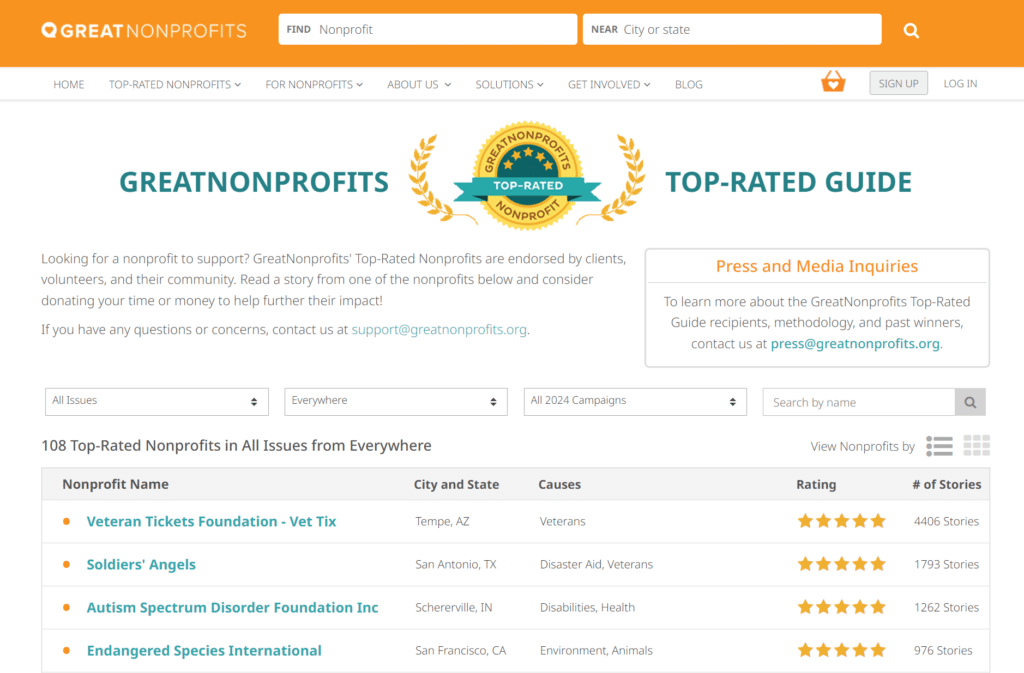
16. Produce Engaging Social Media Content: Sharing stories, updates, and engaging with your audience on platforms like Facebook, Instagram, and Twitter can significantly increase your online presence. This not only fosters community engagement but can also drive traffic to your website. For example, sharing success stories or behind-the-scenes looks at your operations can engage your audience.
One case example is Charity: Water. Charity: Water, known for providing clean water worldwide, has a rich history with social media fundraising. In 2009, they were the first to benefit from a large-scale Twitter fundraiser, engaging users across 200 cities and raising over $250,000. A more recent endeavor, their live-streaming fundraiser, offers valuable insights.
Launched in September 2022, the “StreamForClean” campaign engaged gamers and creators for the entire month. They were encouraged to host live streams using Tiltify to facilitate fundraising efficiently.
During this time, Charity: Water actively engaged their Facebook audience by promoting participation in the stream, offering live stream setup and fundraising tips, and sharing progress updates to celebrate fundraising milestones.
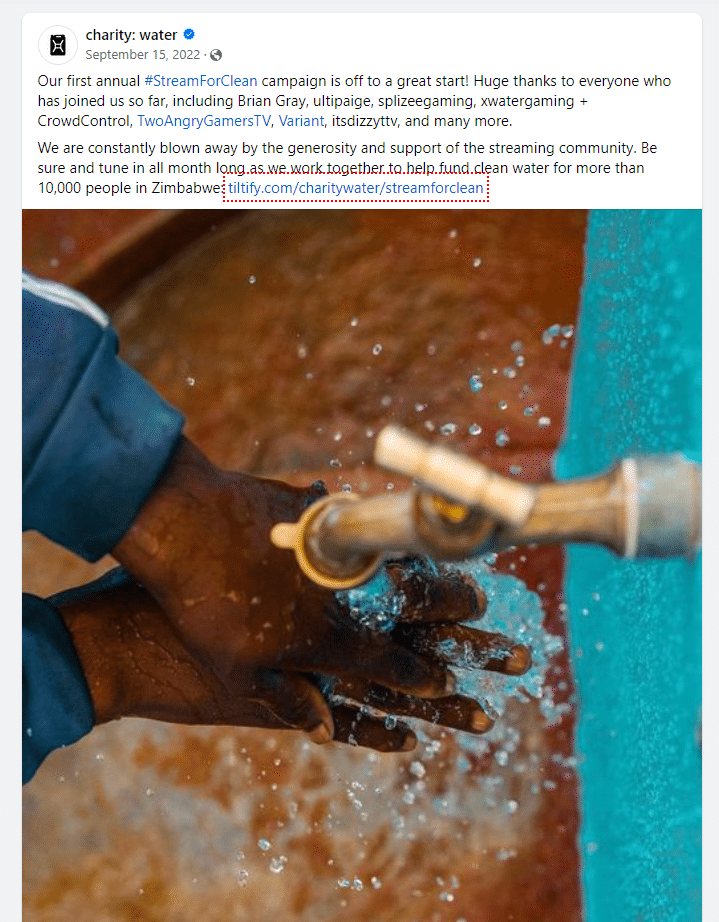
17. Build a Network for Backlinks: Developing relationships with partners, supporters, and related organizations for backlinks is essential for improving your site’s authority. Ensure these backlinks are relevant and high-quality. For example, partnering with a university for a research project could result in a backlink from the university’s website to yours.
18. Engage in Guest Blogging for Quality Backlinks: Writing guest posts for reputable websites in your sector can increase visibility and authority. This not only provides valuable backlinks but also exposes your nonprofit to a broader audience. For example, contributing an article to a popular charity blog or an online magazine focused on social issues can be beneficial. You can reach out to websites related to nonprofit or look for Write for Us notices on these sites.
19. Respond to Journalists’ Queries: Platforms like HARO (Help a Reporter Out), or Featured connect you with journalists looking for expert opinions in your field. This can lead to media mentions and high-quality backlinks. Regularly responding to relevant queries can increase your chances of being featured in news articles or reports.
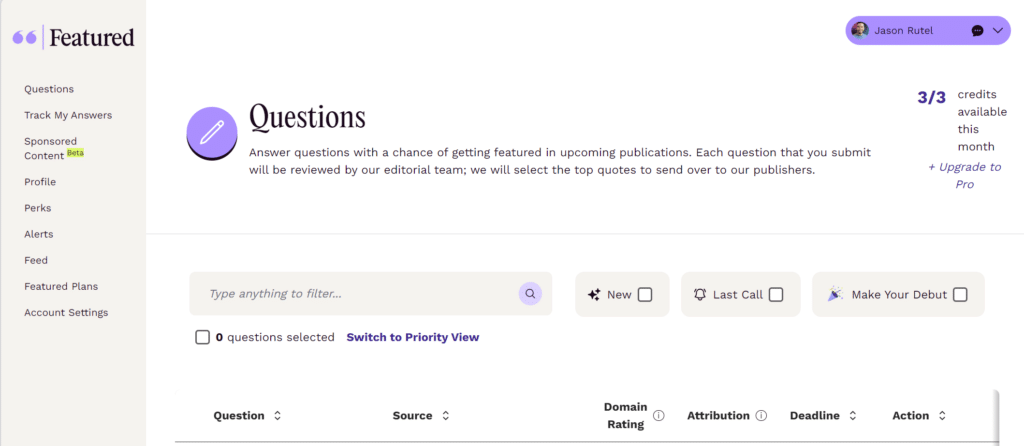
20. Optimize for Branded Searches: Ensure that searches specifically related to your brand bring up accurate and informative results. This involves having well-crafted meta descriptions, titles, and content that reflect your brand’s values and mission. For example, optimizing your website’s home page to include key phrases related to your nonprofit ensures it shows up in searches for your brand name.
You can do this by checking branded search queries on your Google Search Console property. Then add these branded search queries to your titles, meta descriptions, and content.
21. Aim for a Google Knowledge Panel: Working towards getting a Google Knowledge Panel for your nonprofit enhances your visibility and credibility. Keep your nonprofit website and social media profiles up-to-date. Consider setting up a Wikipedia page for your organization, as this can increase the likelihood of getting a panel. A Knowledge Panel provides a quick snapshot of your organization, making it easier for people to find and trust your information.

Implementing these strategies can significantly boost a nonprofit’s online presence, making them more discoverable and appealing to potential supporters, volunteers, and beneficiaries.
Measuring and Tracking the Successes of Your SEO Work
Measuring and tracking the successes of SEO efforts is crucial for nonprofits to evaluate their performance and make informed decisions for future optimization strategies.
Metrics to measure SEO success:
1. Organic Traffic: Track the number of visitors coming to your website through search engines. Tools: Google Analytics 4 (GA4) is ideal for this.
2. Keyword Rankings: Monitor where your website ranks for specific keywords relevant to your cause. Tools: SEMrush and Ahrefs are excellent for tracking keyword positions.
3. Conversion Rates: Measure the percentage of visitors who take a desired action (donations, newsletter signups, volunteer registrations). Tools: Google Analytics 4 (GA4) & Google Tag Manager (GTM) can track conversions by setting up goals. The easiest way to do so is to track your thank you pages as events, and enable them as conversion.
SEO tools to help ease your SEO work
Google Tools:
1. Google Analytics 4: Provides insights into website traffic, user engagement, and the effectiveness of your content. It’s crucial for understanding audience behavior and tracking conversion goals.
2. Google Search Console: Offers data on search queries, website indexing status, and identifies issues like crawl errors or security problems. Essential for monitoring your site’s health and search performance.
Tracking Tools:
1. SEMrush: A comprehensive tool for tracking keyword rankings, analyzing backlink profiles, and conducting site audits. It also offers competitor analysis, which is helpful for benchmarking. SEMrush
Keyword/Backlink Research Tools:
Optimization Testing Tools:
1. Optimizely: Allows nonprofits to conduct A/B testing, multivariate tests, and more to see how changes affect user behavior and website performance.
Other Tools:
1. Social Media Analytics: Platforms like Hootsuite or Sprout Social
offer analytics to understand the performance of your social media campaigns.
2. Content Performance Tools: BuzzSumo is great for analyzing which content performs best in your sector, giving insights into popular topics and content strategies.
3. Hotjar: Provides heatmaps and user feedback tools to understand how users interact with your website, which is valuable for user experience optimization.
Apply These Proven & Effective SEO Strategies
If you’re looking to help your nonprofit improve its SEO efforts and increase visibility on search engines like Google, it’s essential to apply proven and effective SEO strategies to your nonprofit website’s SEO.
Implementing targeted SEO tactics such as keyword optimization, content creation, and link building can improve SEO rankings and attract more organic traffic to your website. Additionally, utilizing on-page SEO techniques, such as meta tags and descriptions, can further enhance your nonprofit’s SEO performance and help your website rank higher in search results.
Developing a comprehensive SEO strategy tailored to the specific needs of your nonprofit can ultimately boost your online presence and make it easier for potential donors and supporters to find and engage with your organization. Taking a proactive approach to improving your nonprofit’s SEO can maximize your website’s visibility and increase the impact of your digital marketing efforts.


